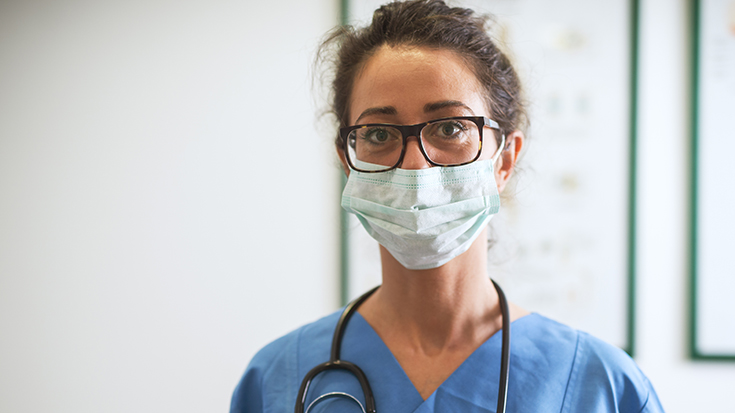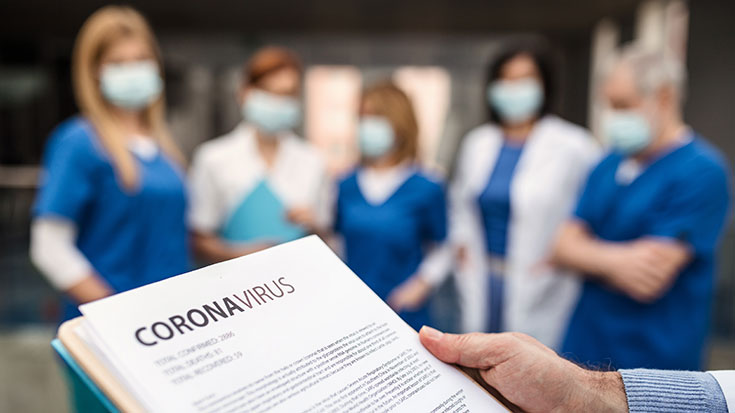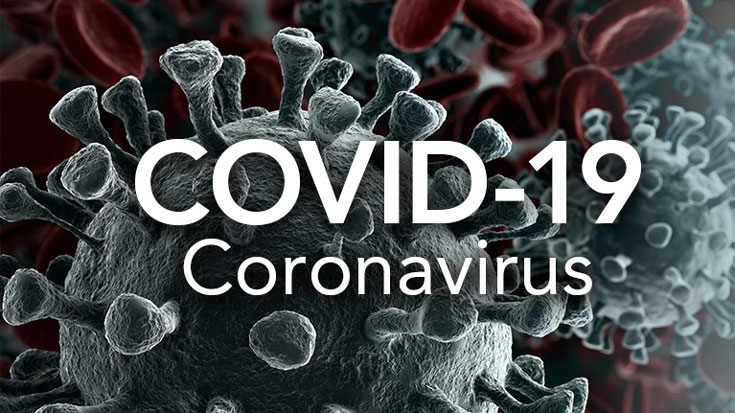
Everyone who works in the respiratory care profession has been touched by COVID-19 in one way or another. Clearly, those on the frontlines in the COVID-19 ICUs and wards have endured the weight of the pandemic, but there has been collateral damage throughout the field. Pulmonary function laboratories have seen more than their fair share.
Jeffrey Haynes, RRT, RPFT, FAARC, is the clinical coordinator of respiratory therapy and the pulmonary function laboratory at St. Joseph Hospital in Nashua, NH. He is a member of the Respiratory Care journal editorial board and is an associate editor of the Canadian Journal of Respiratory Therapy. He is also a member of the NBRC Board of Directors and serves as the vice chair of the NBRC Pulmonary Function Examination Committee.
Most recently, Haynes served as a co-author along with fellow AARC member Kevin McCarthy, RPFT, on the American Thoracic Society (ATS) recommendations on the reopening of PFT labs during COVID-19.
We asked him to fill us in on the special challenges that have been faced by PFT labs across the country since the pandemic began—
What happened to pulmonary function laboratories when the pandemic struck earlier this year?
For pulmonary function laboratories, the COVID-19 pandemic is a doomsday scenario come true. In a matter of weeks laboratories across the country went from full operation to shut down. Many technologists were furloughed, had their hours drastically reduced, or were moved into the ICU to work as a critical care RT. For a PFT technologist who may not have worked in the ICU for years, unexpectedly being thrust into the ICU and being charged with the responsibility of managing unfamiliar ventilators with extremely sick patients suffering from a poorly understood and lethal disease is most assuredly a formidable and frightening challenge.
PFT manufacturers, who are truly a partner of any laboratory, were affected as well. They faced financial difficulties by the immediate loss of orders for consumables, preventive maintenance, and new system installations. It is understood that PFT laboratories cannot function without their manufacturer partners. The impact of any manufacturer going out of business during the pandemic would be devastating.
How did the pandemic impact your patients?
Laboratories were forced to cancel weeks or months of scheduled patient appointments. We may never know the impact of these cancellations on delayed diagnosis, morbidity, and patient outcomes, but patients were clearly affected by the unavailability of pulmonary function testing. Some laboratories were still testing patients for “urgent cases” — e.g., clearance for thoracic surgery — however, this left some laboratory managers in the unenviable position of having to decide what constitutes an “urgent case.” Reopening of services began for many laboratories in the late spring/early summer; however, reopening wasn’t as simple as flipping the closed sign to open; “business as usual” won’t return for some time.
What do you believe are the biggest challenges labs have faced during the pandemic so far and why?
The central challenge for PFT laboratories during the COVID-19 pandemic is patient, staff, and public safety. How does a laboratory perform PFTs during this pandemic without spreading the disease? You can’t find the answer to this question in textbooks and usual sources of guidance were understandably slow to issue recommendations.
Indeed, the ATS didn’t publish formal recommendations for restoring pulmonary services until July 14, 2020, long after many laboratories had already resumed operations.1 Without clear directives, local laboratory managers and infection control professionals had to decide how to proceed with reopening. Some interventions like strict hand washing protocols, screening patients for illness and viral exposure, and mandating that technologists wear full personal protective equipment (PPE) during testing are obvious.
However, important and tough questions remain: should patients have to have a negative COVID test prior to testing? Does testing have to be performed in a negative pressure room? Is it safe to deliver aerosols during a PFT? What’s the best way to clean the laboratory after testing is completed? Is it safe to do stress tests or six-minute walk tests?
The AARConnect Diagnostics Section page has served as an important forum for members to share information, publications, and experiences. I’m proud of how the AARC diagnostics community came together during this challenging time.
What measures are labs taking to overcome these challenges and how do you think they are working to ensure safe and effective testing for their patients?
The first step in the reopening process is to determine the local community prevalence of COVID-19 — easier said than done. Laboratories can be less restrictive in terms of patient scheduling if their community is post peak prevalence, and on a downward trajectory.1,2
As mentioned above, strict hand washing protocols, pre-test patient screening, and full PPE are just the beginning. Whenever possible testing should be performed in a negative pressure room and the air exchange rate should be determined to allow proper time gaps between patients. Disposable filters that have been testing for efficiency at flows higher than 600 L/min should be used. I recommend that laboratory managers verify filter performance with their manufacturer.
Using metered dose inhalers or filtered breath-actuated nebulizers for aerosol delivery is recommended to reduce aerosol exposure. Restricting procedures that are thought to generate more droplets and are more difficult to filter — e.g., exercise testing, challenge testing — may be appropriate until the community prevalence is low. Enhanced cleaning procedures of all surfaces between patients, including the use of ultra-violet light and ozone if available, is obviously important. My feeling from discussions with local colleagues and reading posts on AARConnect is that the pulmonary function testing community has done a superb job of safely resuming pulmonary function testing.
What have you, personally, experienced in terms of testing during the pandemic there in your lab at St. Joseph’s?
Firstly, I never thought I would wear full PPE to perform routine PFTs. It was very strange at first but now I hardly notice it. We encourage patients to bring their own metered dose inhaler with them so we can avoid using nebulizers. In doing so I have seen a lot of expired inhalers, empty inhalers, and bad inhaler technique. This is certainly not a new discovery but it has reaffirmed the importance of verifying that our patients are able to use their inhalers correctly.
Have you witnessed any ill effects on patients who had to have their PFT appointments canceled or postponed due to the pandemic and if so, what is your take-away for your fellow RTs?
Unfortunately, I have witnessed several patients who had their pre-pandemic PFT appointment canceled, deemed non-urgent, whom we later discovered had significant problems. Two patients come to mind; one patient who was referred for cough turned out to have undiagnosed interstitial lung disease, and another patient who had been experiencing dyspnea for many months was found to have tracheal stenosis. These patients and many more experienced respiratory symptoms and uncertainty about their health for many months waiting for their PFT to be rescheduled. It is therefore our responsibility to the communities we serve to resume pulmonary function testing as quickly and safely as we can so that patients can be properly diagnosed and treated.
What are your top recommendations for RTs in other labs who may still be struggling to provide safe testing during the pandemic?
My recommendation for laboratories is to have a written reopening plan based on expert recommendations and to expect that plan to require revisions. Carefully consider the practicality of your plan before seeking approval. I based my reopening plan on the European Respiratory Society (ERS) recommendations,2 which are broken down into three safety levels: pandemic phase, post peak phase, post pandemic phase. Elements of the ATS recommendations were added later when they became available.
It is important that you communicate to the committee that will consider your reopening plan that your recommendations are based on documents written by experts and endorsed by renowned organizations like the ATS and ERS. Formally reference these documents in your written reopening plan and provide copies of the published statements to the committee.
References
- Wilson KC, Kaminsky DA, Michaud G, Sharma S, Nici L, Folz RJ, Barjaktarevic I, Bhakta NR, Cheng G, Chupp GL, Cole A, Dixon AE, Finigan JH, Graham B, Hallstrand TS, Haynes J, Hankinson J, MacIntyre N, Mandel J, McCarthy K, McCormack M, et al. Restoring pulmonary and sleep services as the COVID-19 pandemic lessens: from an association of pulmonary, critical care, and sleep division directors and American Thoracic Society-coordinated task force. Ann Am Thorac Soc. (in press)https://doi.org/10.1513/AnnalsATS.202005-514ST
- European Respiratory Society. Recommendation from ERS Group 9.1 (Respiratory function technologists/Scientists) Lung function testing during COVID-19 pandemic and beyond. Available from: https://ers.app.box.com/s/zs1uu88wy51monr0ewd990itoz4tsn2h (Accessed October 6, 2020).
Email newsroom@aarc.org with questions or comments, we’d love to hear from you.














